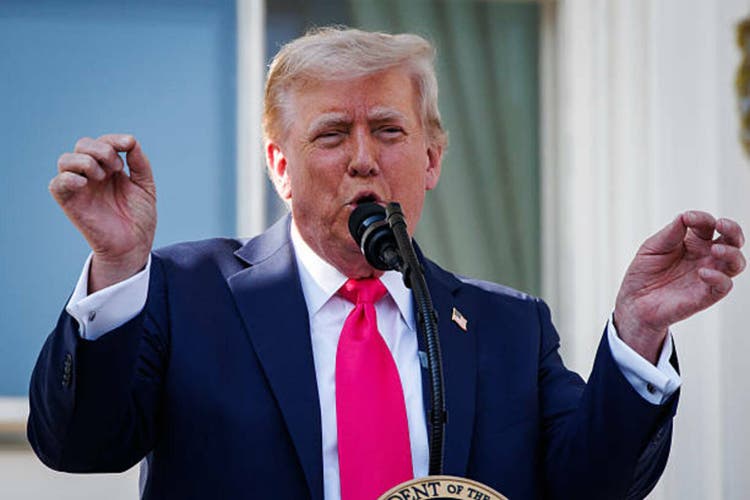
Donald Trump delivers remarks on the jobs report from the White House on March 7, 2025. The latest ... More jobs report released in July warns policymakers that immigration and labor force declines threaten to harm the U.S. economy. (Photo by Anna Moneymaker/Getty Images)
Getty ImagesThe latest jobs report warns policymakers that immigration and labor force declines threaten to harm the U.S. economy. The latest data show changes in immigration policy are reducing the labor supply. Federal Reserve Board Chair Jerome Powell said the Trump administration’s deportation policies are one of the reasons U.S. economic growth has slowed. The administration has also removed employment for several hundred thousand workers, blocked the admission of new refugees and may prevent international students from working on Optional Practical Training and STEM OPT after graduation.
Employment Data Bring Immigration And Labor Force Warnings
On July 3, 2025, the U.S. Bureau of Labor Statistics announced that total nonfarm payroll employment increased by 147,000 in June, while the unemployment rate remained at a low 4.1%. Supporters hailed the report as proof that the Trump administration’s economic policies were working, despite the report containing concerning underlying data.
“The real headline from the recent jobs report should be the falling labor force,” said labor economist Mark Regets, a senior fellow at the National Foundation for American Policy. “The data for the last five months indicate a serious fall in the number of immigrant workers. Despite growth in the unadjusted numbers, the U.S.-born labor force participation rate and the overall seasonally adjusted labor force total suggest that the loss of immigrant labor is not bringing more U.S.-born workers into the labor force.”
The foreign born in the U.S. labor force have declined by 735,000 since January 2025, according to an NFAP analysis of data from the Federal Reserve Bank of St. Louis. Numbers for U.S.-born and foreign-born workers are seasonally unadjusted. The Bureau of Labor Statistics makes seasonal adjustments to labor force data to account for trends, such as fewer people working outdoors in the winter and more people seeking employment after school lets out for the summer.
Regets notes that the labor force tends to grow in June. However, the seasonally adjusted numbers for the whole labor force show a decrease of 364,000 since January 2025. The unadjusted numbers show a 1,009,0000 increase in the total labor force.
White House Deputy Chief of Staff Stephen Miller said on social media, “The universe is healing” after an ally claimed the jobs report showed U.S.-born worker employment increased and foreign-born employment fell in June. The problem with what Miller retweeted: Month-to-month changes in the Current Population Survey often jump around because the standard errors are high. “Any single-month change may be misleading,” notes Regets. Economists would also reject the idea that U.S.-born or foreign-born worker gains need to come at either group’s expense.
In his 2024 Republican National Convention speech, Donald Trump asserted that more than 100% of new jobs during the Biden presidency were “taken by illegal aliens.” The data showed that 59% of employment growth under Biden was for U.S.-born workers. As for employment growth for foreign-born workers during the Biden administration, government statistics do not measure how many lacked legal status. From January 2021 to June 2024, employment grew by 13.4 million—7.9 million for U.S.-born workers and 5.5 million for foreign-born workers.
Over the past year, the economic data do not support the assertion that removing foreign-born workers from the labor force increased U.S.-born labor force participation. The labor force participation rate for the U.S. born declined from 62.1% to 61.8% between June 2024 and June 2025. During the same period, the labor force participation rate for the foreign born also dropped (from 67.0% to 66.3%). Any increase in the unadjusted total numbers in the labor force is solely a result of population changes and the natural rise in June.
“In each of the past three decades, the foreign born have accounted for more than half of America’s labor force growth,” concluded an NFAP analysis in October 2024. “The number of immigrants in the labor force grew by 19.1 million over the past 30 years, while the U.S. born in the labor force grew by only 16.8 million.”
Federal Reserve Board Chairman Jerome Powell speaks during a news conference at the headquarters of ... More the Federal Reserve on December 13, 2023, in Washington, DC. (Photo by Win McNamee/Getty Images)
Getty ImagesThe Impact Of Immigration Policy Changes
On June 12, 2025, the Trump administration ended the CHNV humanitarian parole program for Cubans, Haitians, Nicaraguans and Venezuelans, removing work authorization for up to 528,000 people. Workers with Temporary Protected Status from Haiti, Venezuela, Afghanistan and other countries are also seeing their employment authorization terminated, although a court recently gave Haitians a reprieve. In an executive order issued on January 20, 2025, Trump blocked the admission of refugees to the United States, including approximately 100,000 individuals already approved to enter.
The Trump administration’s actions have harmed employers desperate for workers. “I have healthcare systems for clients that have a dire need for nurses and are forced to wait two or more years for a nurse through the green card process,” according to Colleen F. Molner of the Garfinkel Immigration Law Firm. “On top of that, many of them have been faced with the revocation of work authorization from the humanitarian parole termination for Cubans, Haitians, Nicaraguans and Venezuelans.” In 2024, 99,000 Haitians were working in healthcare occupations in the United States, including 28,000 non-citizens, according to NFAP estimates of the Current Population Survey monthly public use files.
“I represent hospitals in New Jersey, and the termination of parole programs is visibly exacerbating the already serious labor shortage problem in healthcare,” said Rosanna M. Fox of Lepore Taylor Fox LLP. With the termination of CHNV parole and TPS for Venezuelans, and with the uncertainty facing other parole programs, healthcare organizations are scrambling for ways to replace workers who lost work authorization in an already tight market and on very short notice.” She said hospitals across the country have struggled to find nurses, nurse’s aides, environmental services workers and other staff critical to providing health care to Americans.
Colleen F. Molner’s clients in Florida and elsewhere face similar problems in finding workers to fill healthcare positions. “The administration has said it will give a reprieve to those working in agriculture, but what about health care, where we’re also facing a crisis?”
While advocates of more restrictive immigration policies hope removing workers from the economy will raise wages for U.S. workers, economic research calls that into question, particularly because businesses are likely to curtail investment in response to trouble finding qualified workers.
“Immigration, thanks to native-immigrant complementarity and college skill content of immigrants, had a positive and significant effect between +1.7% to +2.6% on wages of less educated native workers, over the period 2000-2019 and no significant wage effect on college educated natives,” according to research by Giovanni Peri and Alessandro Caiumi, economists at the University of California, Davis. “We also calculate a positive employment rate effect for most native [U.S.-born] workers.”
The Economist examined U.S. wage data in occupations with a high proportion of foreign-born workers, including jobs such as janitors and drywall installers. “Immediately before Mr. Trump came to office, average wage growth in these ‘immigration-exposed occupations’ exceeded the overall average,” according to The Economist. “But so far this year, as net migration has plummeted and competition for these jobs has in theory declined, wage growth has actually slowed. Now these occupations have weaker wage growth than the average.”
At a Congressional hearing in June, in response to a question from Rep. Maria Salazar (R-FL), Federal Reserve Board Chair Jerome Powell explained the factors that affect economic growth. “There are two things that affect growth,” he said. “One is growth in the labor force, more people working, and the other thing is productivity, how much do they produce per hour of work. And when you significantly slow the growth of the labor force, you will slow the growth of the economy.”
When asked if economic growth will be affected by fewer workers, Powell replied, “I think that growth will slow and actually is slowing this year, and that’s one of the reasons.”
.png)











 English (US) ·
English (US) ·